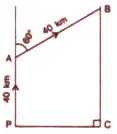Calculate the work performed in launching a rocket of weight P from the ground vertically upwards to a height h.
The correct Answer is:
Topper's Solved these Questions
- APPLICATIONS OF THE DEFINITE INTEGRALBOOK - IA MARONCHAPTER - APPLICATIONS OF THE DEFINITE INTEGRALEXERCISE - Computing Static Moments and Moments of Inertia. Determining Coordinates of the Centre of Gravity
15 Videos
- APPLICATIONS OF THE DEFINITE INTEGRALBOOK - IA MARONCHAPTER - APPLICATIONS OF THE DEFINITE INTEGRALEXERCISE - Geometrical Applications of the Definite Integral
10 Videos
- APPLICATION OF DIFFERENTIAL CALCULUS TO INVESTIGATION OF FUNCTIONSBOOK - IA MARONCHAPTER - APPLICATION OF DIFFERENTIAL CALCULUS TO INVESTIGATION OF FUNCTIONSEXERCISE - ADDITIONAL PROBLEMS
9 Videos
- BASIC CLASSES OF INTEGRABLE FUNCTIONS BOOK - IA MARONCHAPTER - BASIC CLASSES OF INTEGRABLE FUNCTIONS EXERCISE - 5.8 INTEGRATION OF OTHER TRANSCENDENTAL FUNCTIONS
5 Videos
Similar Questions
The work that must be done in lifting a body of weight P from the surface of the earth to a height h is
View SolutionIn the given figure, a rocket is fired vertically upwards from its launching pad P. It first rises 40 km vertically upwards and then 40 km at 60° to the vertical. PA represents the first stage of the journey and AB the second. C is a point vertically below B on the horizontal level as P, calculate :

(i) the height of the rocket when it is at point B.
View Solution
Knowledge Check
The work that must be done in lifting a body of weight P from the surface of the earth to a height h is
APRhR−hBR+hPRhCPRhR+hDR−hPRhA particle is thrown vertically upward with a speed u from the top of a tower of height h from ground level, If after first impact with ground it just reaches to height h from ground the coeffecient of restitution for the collision is :−
A1Bu2C√2ghU2+2ghD√2ghUh=−4.9t2+25t
The equation above expresses the approximate height h, in meters, of a ball t seconds after it is launched vertically upward from the ground with an initial velocity of 25 meters per second. After approximately how many seconds will the ball hit the ground?A3.5B4.0C4.5D5.0
In the given figure, a rocket is fired vertically upwards from its launching pad P. It first rises 40 km vertically upwards and then 40 km at 60° to the vertical. PA represents the first stage of the journey and AB the second. C is a point vertically below B on the horizontal level as P, calculate :

(ii) the horizontal distance of point C from P.
View SolutionA particle is thrown vertically upward with a speed u from the top of a tower of height h from ground level, If after first impact with ground it just reaches to height h from ground the coeffecient of restitution for the collision is :−
View SolutionA prototype of a rocket is fired from the ground. The rocket rises vertically up with a uniform acceleration of 54m/s2. 8 second after the start a small nut gets detached from the rocket. Assume that the rocket keeps rising with the constant acceleration.
(a) What is the height of the rocket at the instant the nut lands on the ground
(b) Plot the velocity – time graph for the motion of the nut after it separates from the rocket till it hits the ground. Plot the same velocity– time graph in the reference frame of the rocket. Take vertically upward direction as positive and g=10m/s2
View SolutionA stone is dropped from the top of a tower of height h=60m. Simultaneously another stone is projected vertically upwards from the foot of the tower. They meet at a height 2h3 from the ground level. The initial velocity of the stone projected upwards is (g=10ms−2)
View SolutionA rocket in launched vertically from the sruface of earth with an initial velocity u. Find the height up to which the rocket can go from the surface velocity u. Find t eh height up to which the rocket can go from the surface of earth before back or earth
View Solution
